BTTF3 DeLorean


This section written by Tom Silknitter in September 2010
In the summer of 1984, Universal Studios had given the green light to Robert Zemeckis' film Back to the Future. In the film, a wild eccentric home garage inventor by the name of Doctor Emmett Brown had discovered the secret to time travel. The film had taken years to get produced and originally the time machine was a room chamber. For the film's finale, Brown had modified a refrigerator to become a "mobile" time chamber. Over time, writers Robert Zemeckis and Bob Gale had shifted their creative mindset; "We worried that kids would start locking themselves in refrigerators. Plus it would be foolish not to make it mobile." Zemeckis stated in 1985.
One idea was that it could be a tank that would travel in all terrains and would have been practical from a real life standpoint. However, a different creative hook was found. "This idea, if it were in a really cool looking car which you could drive fast, would also create problems for the person who goes back in time. It would be like he was in a vehicle from another world." Zemeckis stated. Looking at science fiction themes of the 1950s and various cars "The idea of the gull wing door and the concept that in the 50s this would be mistaken for a flying saucer, that was what nailed it for us," co-creator and producer Bob Gale stated. The decision was made; the time machine was going to be a sports car with gull wing doors.

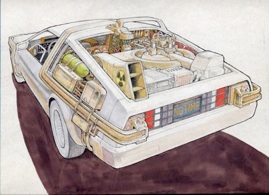
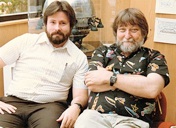

The film's production bought three cars and had them shipped to Filmtrix. Construction started in October 1984. The art department wanted there to be an art department liaison with Filmtrix. Special effects supervisor Mike Fink joined the production as the DeLorean build coordinator. One of the key items that Fink designed was the flux capacitor. Fink got called away to another film production and he asked Michael Scheffe to continue "Mike Fink got an offer and said maybe if I make nice with the art department you could have my job. So I drag my portfolio in and what an incredible experience. The car had been pretty much figured out by Ron Cobb, Andy Probert and Mike so we got to finish a thing in progress," Scheffe told the audience at the 2010 UNA Film Festival.
Scheffe, similar to Probert, had designed a key prop vehicle for a Universal Studios television show, the famous modified K.I.T.T. in Knight Rider. Designated as the construction coordinator of the DeLorean, Scheffe started by sorting through the various electrical surplus items that were purchased. "There is no time to build everything from scratch. You have to go with salvage parts; finding or making them. So my assignment was to look at stuff, draw it as if it was in the car, run that and show the art department; and if they approved the work, we were in. The guys would take the sketch and make it work from there." Scheffe told a special effects workshop in 2010. The final cars ended up being very close in feel and texture of Cobb's first sketches, just refined by all the different creative people involved.
Filmtrix's crew converted the three DeLoreans in the span of around 10 weeks. The three cars were created to provide different services during filming. The "A" car was dressed up to be the hero car with full light effects and details inside and out. The "B" car was also dressed up, but was designated as the stunt car with special riggings for the fire trail effects. The "C" car ended up being dressed up with just an interior and cut up into pieces so that the camera could be put inside the car for interior shots and inserts. The total costs for the DeLoreans and the completed prop work was around $150,000.
The DeLorean was first filmed on Dec. 14, 1984 at the Universal backlot. Eric Stoltz and Christopher Lloyd were acting out the final run down of the lightning strike. However, in terms of the rigors of filmmaking, the DeLorean sometimes caused some problems. Second unit director Frank Marshal who had to deal with many of the DeLorean's action scenes recalled this in 1985, "We were asking a car to do something it doesn't normally do. Unless you had hairdryers around you couldn't get the people out." There was a constant crew working on the modified cars. Kevin Pike remembers how much attention the DeLoreans required to fulfill shooting requirements, "It required constant maintenance. If it rained, it got wet and water went down in the battery. There was no windshield in the back. You had to be able to take everything apart. You had to take all the vents off to even open up and get to the engine. You had to take the vents off to change the license plate. Transportation had to service it and change fuel and do everything they had to do to make sure it ran. There was a mechanic on set all the time that knew the engine inside and out so they had their hands in it. There was a constant crew on that car from when the DeLoreans first came to when they wrapped the movie."
In 1988 filming of Back to the Future Part 2 started. The "B" car was pulled out of storage and prepped for use in the sequel; this car was used mostly for second unit work and on location photography. The "A" car, from being out in the elements on display for fans, had to have mechanical and cosmetic restoration. The "C" process car was pulled out of storage at Universal Studios. Since the DeLorean in the sequel had to fly, Michael Lantieri, who had taken over the reins as mechanical effects supervisor, had decided to have a DeLorean built out of fiberglass. Car customizer Gene Winfield molded an entire DeLorean in fiberglass, added some lights to the bottom and made riggings so the wheels would fold in and out for hover mode using concept art from ILM art director John Bell.
The screenplay went through several drafts; at one point the screenplay had grown too large to be managed as a single film. The screenplay was divided and Back to the Future Part 3 was born. Illustrator Tim Flattery who had been busy designing and coordinating the construction of several 2015 cars in Part 2 was given a new assignment, "It was more of an extension of the work I did for Part 2. As you know, they ended up doing Part 2 & 3 back-to-back. I thought I was done with the production with Part 2. Since in the script they had the off-road DeLorean, they asked me if I could make it look like something Doc Brown would do in the '50s, so I said sure. So I had to design a DeLorean that would handle itself on off-road terrain and look like Doc Brown fixed it in the '50s. I did a few sketches and they said, ‘Good, now build it!’", Flattery told bttf.com.
"I looked at cars of the '50s. You add the white wall tires, the moon hubcaps, and you get the look of a DeLorean repaired in the '50s!", Flattery explaining the birth of the "desert" DeLorean. Meanwhile Scheffe still continued working with the Back to the Future trilogy by designing a 1950's version of a time circuit control microchip, which ended up being mounted to the hood of the DeLorean. Scheffe created about 5 different concepts of the "hood box" as it is known in fandom.
Flattery then coordinated the building of "desert" DeLoreans. "I had Conejo Offroad build the cars for me. They built the chassis for me from the ground up. It is an off road dune buggy company that builds these things as a profession. Since we had to have the cars handle the desert terrain I had them do it for me. We built two off-road DeLoreans. They put the DeLorean body on the chassis they built with Volkswagen performance engines." The modified DeLoreans were then delivered to the film production for prop dressing. One car was dressed with what looks like left over parts from the creation of the Part 1 car, which matches stories that when the sequels started, production got extra parts from Filmtrix. The second desert car had lots of resin cast pieces and since the surplus supplies weren't as abundant as they were in 1985, substitute pieces were found and installed on the DeLorean. There was one last time machine built for the trilogy, a second unit/stunt train wheeled DeLorean that was dressed with similar props as the second desert car.
For filming of the last film, the "A" car was used for some close up and hero on location work. The "B" car was modified to run on the railroad tracks for the hero 1885 scenes. It was then kit bashed and loaded with explosives and used as the car that was actually destroyed at the end of the film. The other train wheel DeLorean was the one that popped a wheelie and was the one Michael J. Fox sat in when he rolled back into 1985. The "C" car was used again for insert/studio scenes, it actually got dressed up more and had some exterior wiring and flux boxes added to it for some scenes and even was taken on location for some pick up shots. The two desert cars were used for the 1955 drive-in scene and the various scenes in the 1885 desert. The one desert car was actually ripped apart, "We put cars through hell in a movie. Stuff would get dented and we ended up cannibalizing one car for the other cars. So we would pull the fender off the worst looking car, and by the end of the movie, I don't remember how many cars we had that were drivable," Bob Gale reflected at a DeLorean Car Show.
So where are they all now?

After filming, the "A" car has remained at Universal Studios Hollywood. It was used in several promotional pieces, including but not limited to: BTTF NBC Night, Secrets of the BTTF Trilogy, Earth Day Special, BTTF Ride footage, and the BTTF Cartoon Series. The car is still at Universal Studios Hollywood. It has been used mostly as a show and Universal Studios Hollywood attraction piece.
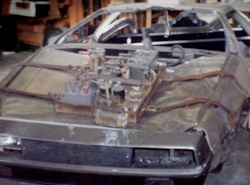
The "B" car used in all three films was left as a pile of rubble. Movie car customizer Jay Ohrberg was contracted by Universal Studios to tour Back to the Future vehicles to promote the sequels and the Ride. Ohrberg built several DeLorean time machines and used the "B" car wreckage to build his fleet of cars. Many original screen used "B" car props can be seen on several of his official replicas. The actual "B" car's body panels were put together and sold to Planet Hollywood where one of the Part 3 hood boxes was mounted to it as dressing. The car currently is hanging upside down in Planet Hollywood Hawaii.
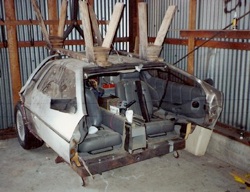
The "C" car was left to rot away at Universal Studios Hollywood. However, in the early 2000’s, many of the parts that were left were put on a DeLorean modified by Tom Talmon Studios for Universal Japan. These screen used parts can still be seen at Universal Studios Japan today.
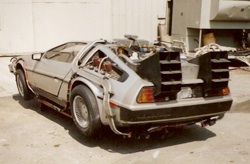
The fiberglass car was used in the Universal Studios Hollywood Special Effects Stage attraction; it was then left to sit in a warehouse in Universal Studios. Within the last few years the car was offered for sale by Hollywood Parts, but it went unsold and was reported destroyed by Universal Studios.

The stunt train car has been on display at Universal Studios Florida since the ride opened in the early 1990s. This car actually was also used in the filming of the ride. This was the car that Tom Wilson sat in for the ride footage, and this was the car that was crashed at the end into the Institute of Future Technology. This car still has the rigging on the frame for the train wheelie scene.
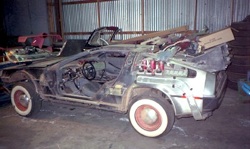
The one desert car with the blue cross over tube was also used for awhile in the Special Effects Stage attraction at Universal Studios Hollywood. This car was left to rot away at Universal Studios Hollywood. However, Tom Talmon Studios used parts off of this car including the rear deck/vents to create the Universal Studios Japan car.
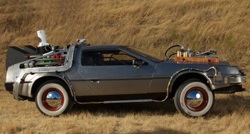
The last desert car... well we know the story of that car. It went to Japan for display, some props were taken off by workers, then the flux capacitor was actually removed from the car and used as a prop in the BTTF cartoon live action sections. It was then purchased from Universal Studios by ScreenUsed to be restored and documented here.
Our Thanks to Tom Silknitter for his fine contribution. Photos are courtesy of the movie company or copyright owner.


Restoration images courtesy of Brian DosSantos, final completed pictures courtesy of Eric DosSantos, and most text courtesy of ScreenUsed. All other images are property of the respective movie studio or copyright owner.